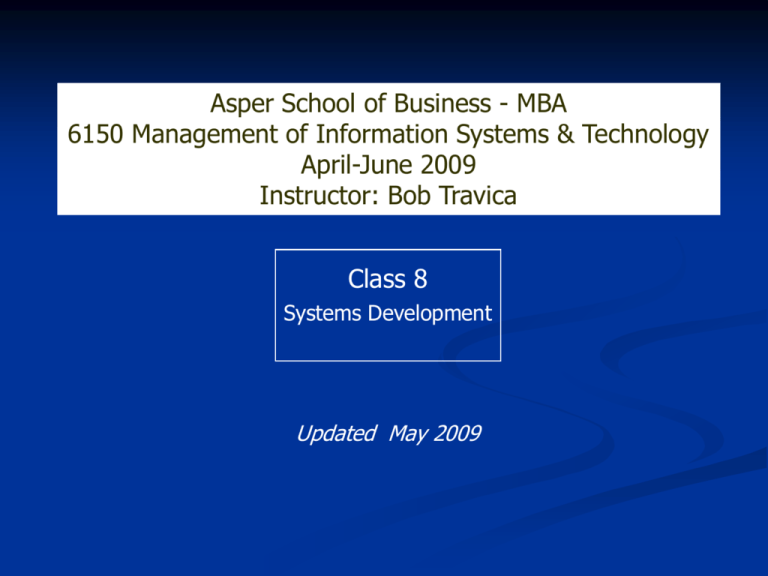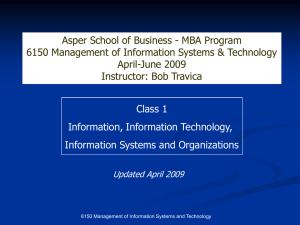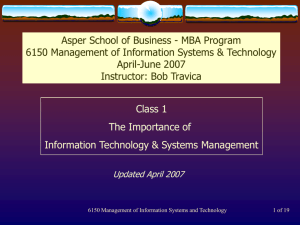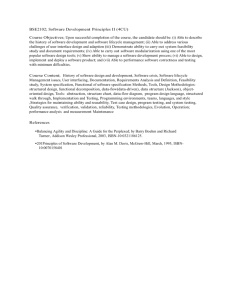Systems Development
advertisement

Asper School of Business - MBA 6150 Management of Information Systems & Technology April-June 2009 Instructor: Bob Travica Class 8 Systems Development Updated May 2009 Outline • System development methodologies • Feasibility of IS development project • Risks of IS development project • Management of IS development project • Systems’ business value - planning and monitoring • Messages for change leader 6150 Management of Information Systems & Technology 2 of 12 System Development Methodologies • Structured approach (“waterfall model”), system life cycle (SLC) a as a sequence of stages: Note: Arrows mean relationships between SLC and organization. Decide which system to build. Assess expected value, Systems feasibility, risks. (see slide 12) Planning Get system requirements Create system “on paper” Business use of system, and upgrading Code, assemble software Install software on production hardware; Train users Mount software on test hardware and study performance 3 of 12 Rapid Application Development • IT changes (components, Object-Oriented tech.), business too need of speed in SLC Analysis & Design (a function, a part of user interface) User’s Testing Construction Installation • Build system’s functions & user interface quickly, piece by piece • Keep revising design (iterate) based on user’s feedback 6150 Management of Information Systems & Technology 4 of 12 ERP Systems Development • Markus & Tanis: Four-Phase Enterprise Systems Experience Cycle 1. Chartering (Planning) Phases 2. Project (Development, Implementation – configuring of-theshelf software rather than coding) 3. Shakedown (“Go live” to achieve system’s routine use – process change challenge) • Cases on Provincial Power Corporation and Dow Corning 6150 Management of Information Systems & Technology 5 of 12 IS Project Feasibility (Making Business Case for IS) • Systems are developed via team projects (mini case “A day in life…”) • Economic feasibility (C/B, ROI, Break-Even, Net Present Value… Scoring method often used in selecting alternative projects. mini case on Trucking company) • Technical feasibility (capability of building or maintaining system) • Organizational feasibility (capability of adopting system) • Operational feasibility (capability of maintaining normal operations) • Schedule feasibility (meeting deadline for system’s roll out) • Political feasibility (capability of implementing system given political setup) 6150 Management of Information Systems & Technology 6 of 12 F (Also see Fig. 10-1, p. 368: Leadership, Employees, Project Scope & Urgency) F F F 6150 Management of Information Systems & Technology 7 of 12 IS Project Management • Managing expectations (dreams, best of possible alternatives) of users and technologists • Managing nuts & bolts of IS development project (the daily grind) – mini case “A day in life….”) : - Project tasks - Time - People (IS staff, others) - Money 6150 Management of Information Systems & Technology 8 of 12 Managing Project Tasks 6150 Management of Information Systems & Technology 9 of 12 Managing Project Time • Critical path method for assessing tasks time and risks: which tasks can/cannot be delayed. 6150 Management of Information Systems & Technology 10 of 12 Managing People – IS Project Team • Project manager manages/influences: - IS staff (systems analyst, programmer, business analyst, database, network, and content experts) - Others: Expert User Vendor End-User Development Project Team Supervisory Management Executive Department Manager • Burnout problem (e.g.: Netscape - 24/7 work vs. SAS Corp. gate closes at 5 pm) • Management of motivation (e.g.: Microsoft – work space, status, money) 6150 Management of Information Systems & Technology More 11 of 12 Systems’ Business Value - Planning and Monitoring • Formal financial and combined methods used for • Planning which systems to build • Monitoring returns (value) from system • Financial methods: • Cost-Benefit Analysis (CBA, basis to other methods) • ROI, Break-Even Analysis… • Tangible costs easier to estimate than tangible benefits; Cost savings main tangible benefit (Trucking co.) • Importance of intangible benefits 6150 Management of Information Systems & Technology 12 of 12 Messages for Change Leader • Reason for change must be in org. problem - not mere technological change • Plan system well, assess feasibility thoroughly, and consider alternative development methodologies (if possible) • If technical expertise is missing, hire a consultant • Have a dedicated system project team • For ERP systems, consider alternatives based on the type of organization you are/want to be, and engage in vendor management • For ERP systems, be aware of organizational change and the need to teach it • Provide resources for appropriate IT training 6150 Management of Information Systems & Technology







